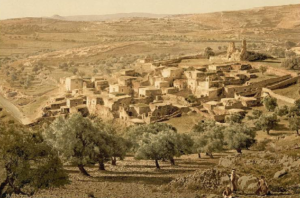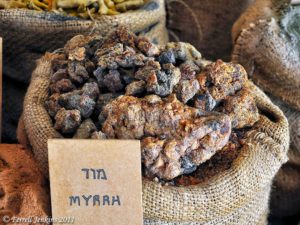WHAT REALLY HAPPENED IN HOLY WEEK? Part 8
SATURDAY  Bethany in the 19th century
Bethany in the 19th century
What happened on Saturday the day after Jesus death by crucifixion?
Nothing.
It was the Sabbath, and the disciples “rested according to the commandment.” (Luke.23.56). Not just the Eleven, remaining inner circle, but also at least half a dozen women and other disciples – perhaps two dozen? In six weeks the number of disciples living together would number 120. (Luke 24.33; Acts 1.15)
There was of course a lot going on elsewhere. There were all the sacrifices for the Feast of Unleavened Bread, celebrating the first harvest of the year. The sacrifices took precedence over the sabbath. The temple was full of pilgrims again, though of course no traders as yet. But the disciples, we can be sure, kept themselves indoors in the house in Bethany which was their base, with “the doors locked for fear of the Jews” (John 20.19).
They must have been in shock and in grief, mulling over the destruction of all their hopes. Their feelings are summed up by two followers who met a stranger while walking to Emmaus the following day. They talked of “Jesus of Nazareth, who was a prophet mighty in deed and word before God and all the people, but our chief priests and leaders handed him over to be condemned to death and crucified him. But we had hoped that he was the one to redeem Israel.” (Luke 24.19-21)
After sunset the women went out shopping. Jewish days lasted from sunset to sunset,  so dusk marked the end of the sabbath when you could go out to buy things again. They went to the spice sellers to buy spices and ointments, probably a mixture of myrrh and aloes (John 19.39). Perhaps there were shops in Bethany, perhaps they had to walk the one and a half miles to Jerusalem. By the time they went to sleep they were ready for an early start to go to Jesus tomb and anoint his body for a proper burial.
so dusk marked the end of the sabbath when you could go out to buy things again. They went to the spice sellers to buy spices and ointments, probably a mixture of myrrh and aloes (John 19.39). Perhaps there were shops in Bethany, perhaps they had to walk the one and a half miles to Jerusalem. By the time they went to sleep they were ready for an early start to go to Jesus tomb and anoint his body for a proper burial.
But what did they find when they go to the site of the tomb just after dawn? See tomorrow’s blog.
